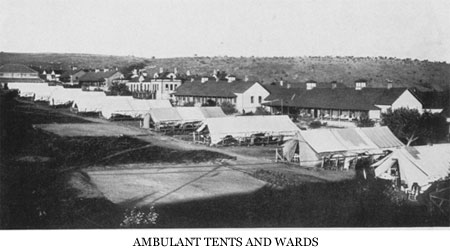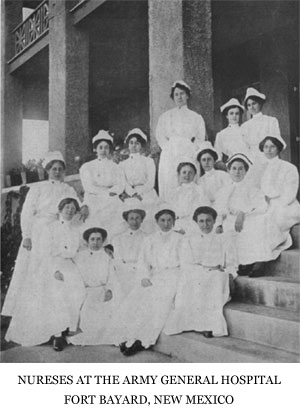© Constance J. Moore
Colonel, ANC (Retired), ANCA Historian
 In 1903, after traveling by train through a sparsely-populated, barren landscape, Army nurses were delighted to find their new assignment, Fort Bayard, New Mexico, neatly landscaped with green lawns, shade trees and flowers. One nurse described it as "a very large place, comprising within its boundaries an officers' row, a nurses' home1, X-ray laboratory, officers' hospital and mess hall2, two large hospital [buildings] for the enlisted men, an operating room, drug room, large dining hall and main kitchen."3 Army nurses worked at the post's sanatorium caring for soldiers who had contracted pulmonary tuberculosis.
In 1903, after traveling by train through a sparsely-populated, barren landscape, Army nurses were delighted to find their new assignment, Fort Bayard, New Mexico, neatly landscaped with green lawns, shade trees and flowers. One nurse described it as "a very large place, comprising within its boundaries an officers' row, a nurses' home1, X-ray laboratory, officers' hospital and mess hall2, two large hospital [buildings] for the enlisted men, an operating room, drug room, large dining hall and main kitchen."3 Army nurses worked at the post's sanatorium caring for soldiers who had contracted pulmonary tuberculosis.
Although remote, the fort had become more accessible after 1891 when a railway depot was established at the nearby town of Bayard, New Mexico. More important, at 6,100 ft. and with a dry, sunny climate, the fort lay within what proponents of climatological therapy termed the "zone of immunity."4 Practicing state-of-the-art healthcare, it was believed that prolonged exposure to a favorable climate would cure tuberculosis.
Nursing care revolved around the tried and true trifecta: good food, rest and fresh air. One nurse managed the preparation of high caloric food and the serving of nutritious meals. With no concerns about cholesterol, the patients' diet was rich in dairy products — up to three dozen eggs and 14 quarts of milk were generally consumed each week by each patient.5 Fattening foods were also served as snacks between meals at 1000, 1500 and 2000 hours. Miss6 Hamill remembered, "We saw splendid results [weight gain] when olive oil was given in hot milk [during snack times]."7 Weekly weights were required and progress noted for the physicians' report. As a result, in one situation, a patient gained 50 pounds in four months.8
 The rest protocol was strictly followed. Miss Young stated, "Patients were subject to few restrictions.... The only requirement absolutely insisted upon [was] that they should rest for certain periods each day."9 After the first and second meals, patients were required to lie down. At 1500 hours, all patients reposed until 1700 hours. Even bathing — of sorts — was accomplished in a recumbent position. Nurses supervised patients' daily "sun baths" where they exposed the men's10 chest to the sun until "copper colored."11
The rest protocol was strictly followed. Miss Young stated, "Patients were subject to few restrictions.... The only requirement absolutely insisted upon [was] that they should rest for certain periods each day."9 After the first and second meals, patients were required to lie down. At 1500 hours, all patients reposed until 1700 hours. Even bathing — of sorts — was accomplished in a recumbent position. Nurses supervised patients' daily "sun baths" where they exposed the men's10 chest to the sun until "copper colored."11
Patients were encouraged to be out of doors as much as possible. Miss Young stated, "They were free to roam at will through the wild country surrounding the Fort."12 Patients had books, music, clubs, poolrooms, polo space, and tennis courts for their enjoyment and to keep their morale up. They were advised "never to sleep in a closed room; keep at least one window open no matter what the weather.13 Even the sicker ones were wheeled in their beds out on the porches of various hospital units to breathe in the crisp, dry air.
The more critically ill soldiers were ordered on bed rest until they were no longer had a fever. To accomplish this outcome, Army nurses "fed them a liquid diet; injected morphine for "nervousness;" ensured absolute bed rest; and withheld all stimulants."14 It was thought that these measures lowered blood pressures, decreased or eliminated fevers and reduced chances of hemorrhage. Generally, this phase of nursing care lasted two weeks. By the third week, most individuals were allowed to sit up in a chair or placed in wheelchairs and taken to sit on the unit porches. If patients continued to improve, they were transferred to the "ambulant" units. All patients who were up and about carried paper sputum cups. Disposal bags were conveniently placed throughout the grounds and hospital.
The reward Army nurses most cherished was having a patient recover and be discharged to live a normal life. Without the diligent nursing care by Army nurses a far greater number of soldiers would have succumbed to this virulent disease.
- Army nurses were single or widowed women who were required to live on post.
- Separate hospital and messing facility for officers and enlisted were the norm until World War II.
- Hamill, E.C. “The Fort Bayard Hospital for Tuberculosis,” The American Journal of Nursing, 18(8): 665.
- Dammer, D. “Establishment of Fort Bayard Army Post,” New Mexico Office of the State Historian, (Accessed on July 30 2012).
- Delano, Jane. “The World’s War against Consumption,” The American Journal of Nursing, 4(6): 440.
- The common form of address was “Miss” since Army nurses did not hold rank and were not allowed to marry.
- Hamill, E.C. “The Fort Bayard Hospital for Tuberculosis,” The American Journal of Nursing, 18(8): 666.
- Ibid, 666.
- Young, Agnes. “Notes from Fort Bayard, New Mexico,” The American Journal of Nursing, 6(6): 370.
- Patients were all men. If a nurse became ill, she would be transferred to another hospital.
- Hamill, E.C. “The Fort Bayard Hospital for Tuberculosis,” The American Journal of Nursing, 18(8): 666.
- Young, Agnes. “Notes from Fort Bayard, New Mexico,” The American Journal of Nursing, 6(6): 370.
- Delano, Jane. “The World’s War against Consumption,” The American Journal of Nursing, 4(6): 442.
- Young, Agnes. “Notes from Fort Bayard, New Mexico,” The American Journal of Nursing, 6(6): 372.